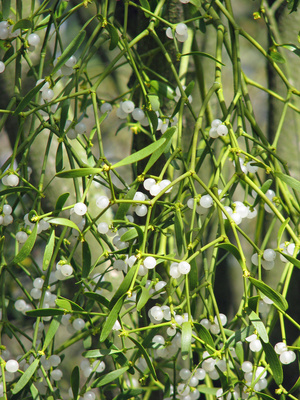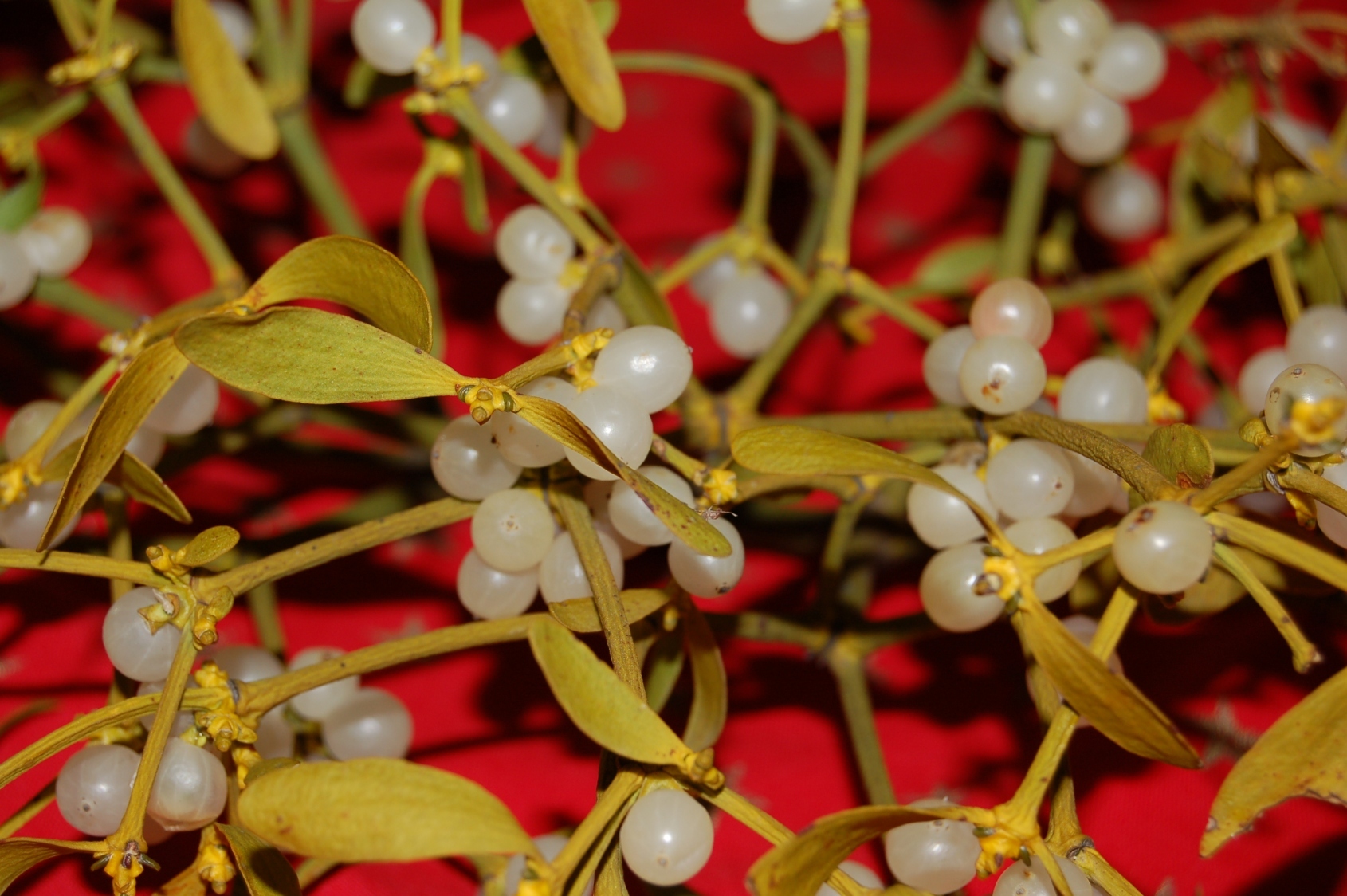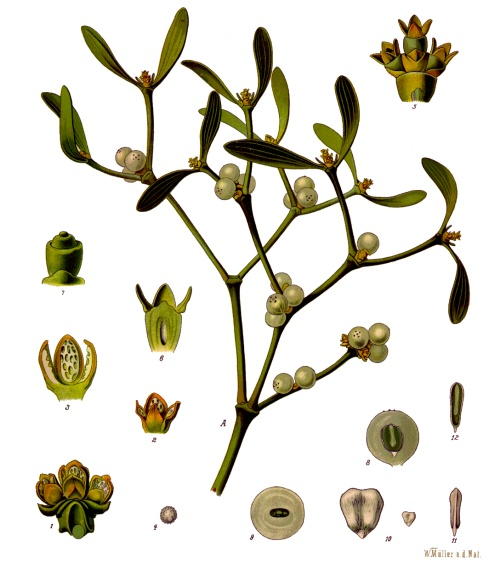Viscum album (L)

 Synonyms: European mistletoe, birdlime,
all-heal, devil's fuge, Herbe de la Croix, Lignum crucis
Synonyms: European mistletoe, birdlime,
all-heal, devil's fuge, Herbe de la Croix, Lignum crucis
Order: Loranthaceae
Description: Viscum is an evergreen shrub, hemiparasitic on the branches of deciduous trees, particularly oak, chestnut, apple or black poplar. It has repeatedly forked green stems and opposite pairs of oblanceolate, leathery leaves, bearing small heads of unisexual yellow-green flowers in spring. The female flowers are solitary; the male flowers occur in clusters of three to five. The female flowers give way to white berries containing one seed. It is found throughout Europe, Asia and North Africa (North American mistletoe is a different species).
Parts used: young leafy twigs
Collection: in spring, just before the berries form.
Constituents: These may vary according to the host plant, but include glycoproteins, a cardioactive polypeptide-carbohydrate (viscotoxin), flavonoids (usually quercitin-derived but dependent on the host tree to some extent), phenylcarboxylic acids (caffeic and gentisic), oleanolic acid, triterpenoid saponins (sapogenin), cholines, histamine, resin, tannin, mucilage, traces of an alkaloid, lignans
Actions: hypotensive, vasodilator, cardiac tonic, sedative, antispasmodic, nervine, relaxant, diuretic, immunostimulant, reputed neoplastic
Indications: hypertension, arteriosclerosis, nervous tachycardia, hypertensive headache, chorea, hysteria.
 Therapeutics and Pharmacology: Viscum
slows and steadies excessive heart rate and dilates the arteries, thereby lowering blood pressure. It acts directly on the vagus nerve to reduce heart
rate while strengthening the peripheral capillary walls. It also has a sedative
and tonic effect on the nervous system. It is indicated particularly when high
blood pressure is associated with nervous tension and a high pulse rate, as well
as for symptoms of nervous tension and spasm. Its cardiotonic action is thought to be due to the
lignans, while the hypotensive
action is believed to be due to a choline derivative related to acetylcholine.
Choline derivatives bring about parasympathetic stimulation and vasodilation.
Therapeutics and Pharmacology: Viscum
slows and steadies excessive heart rate and dilates the arteries, thereby lowering blood pressure. It acts directly on the vagus nerve to reduce heart
rate while strengthening the peripheral capillary walls. It also has a sedative
and tonic effect on the nervous system. It is indicated particularly when high
blood pressure is associated with nervous tension and a high pulse rate, as well
as for symptoms of nervous tension and spasm. Its cardiotonic action is thought to be due to the
lignans, while the hypotensive
action is believed to be due to a choline derivative related to acetylcholine.
Choline derivatives bring about parasympathetic stimulation and vasodilation.
Viscum has subjective effects on headaches, dizziness, energy loss, irritability and other symptoms connected with raised blood pressure. Some controversy exists as to its supposed toxic effects on the liver but to date these remain unsubstantiated. There is evidence to suggest that mistletoe may have anti-tumour activity.
Combinations: Viscum may be combined with
Crataegus and/or Tilia in
benign hypertension.
Caution: The berries are highly poisonous and the herb should only be prescribed by a qualified practitioner. Viscum should be avoided in pregnancy.
Preparation and Dosage: (thrice daily)
Regulatory Status: Berries P
Dried leaves: 2-6g or by infusion
Liquid Extract: 1:1 in 25% alcohol, 1-3ml
Tincture: 1:5 in 45% alcohol, 0.5ml
Infusion: 1:20 in cold water
Additional Comments: Mistletoe was sacred to the ancient druids and the sprigs were believed to dispel evil spirits and to herald the New Year. The Latin name Viscum refers to the stickiness of the seeds, a property essential to the propagation of mistletoe, as its seed must stick to the trunk of its host long enough to germinate and insert a root into the bark for nutrients. One of the explanations for its common name is that mistletoe is derived from the Celtic mil'ioc, meaning all-heal.
Bibliography
BHMA 1983 British Herbal Pharmacopoeia, BHMA, Bournemouth.
Capernaros, Z. 1994 The Golden Bough: The Case for Mistletoe, in European Journal of Herbal Medicine, Vol. 1, No. 1, 1994.
Grieve, M. 1931 A Modern Herbal, (ed. C.F. Leyel 1985), London.
Hoffmann, D. 1990 The New Holistic Herbal, Second Edition, Element, Shaftesbury.
Lust, J. 1990 The Herb Book, Bantam, London.
Mabey, R. (ed.) 1991 The Complete New Herbal, Penguin, London.
Mills, S.Y. 1993 The A-Z of Modern Herbalism, Diamond Books, London.
Ody, P. 1993 The Herb Society's Complete Medicinal Herbal, Dorling Kindersley, London.
Polunin, M. and Robbins, C. 1992 The Natural Pharmacy, Dorling Kindersley, London.
Weiss, R.F. 1991 Herbal Medicine, Beaconsfield Arcanum, Beaconsfield.
Wren, R.C. 1988 Potter's New Cyclopaedia of Botanical Drugs and Preparations, C.W.Daniel, Saffron Walden.










